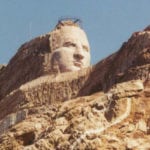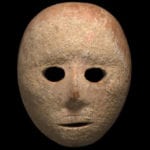 Music
Music  Music
Music  History
History 10 Less Than Jolly Events That Occurred on December 25
 Weird Stuff
Weird Stuff 10 Funny Ways That Researchers Overthink Christmas
 Politics
Politics 10 Political Scandals That Sent Crowds Into the Streets
 Weird Stuff
Weird Stuff Ten Bizarre Facts About The Doge Meme
 Our World
Our World 10 Ways Your Christmas Tree Is More Lit Than You Think
 Movies and TV
Movies and TV The 10 Coolest Stars to Set Sail on The Love Boat
 History
History 10 Things You Didn’t Know About the American National Anthem
 Technology
Technology Top 10 Everyday Tech Buzzwords That Hide a Darker Past
 Humans
Humans 10 Everyday Human Behaviors That Are Actually Survival Instincts
 Music
Music 10 Surprising Origin Stories of Your Favorite Holiday Songs
 History
History 10 Less Than Jolly Events That Occurred on December 25
 Weird Stuff
Weird Stuff 10 Funny Ways That Researchers Overthink Christmas
Who's Behind Listverse?

Jamie Frater
Head Editor
Jamie founded Listverse due to an insatiable desire to share fascinating, obscure, and bizarre facts. He has been a guest speaker on numerous national radio and television stations and is a five time published author.
More About Us Politics
Politics 10 Political Scandals That Sent Crowds Into the Streets
 Weird Stuff
Weird Stuff Ten Bizarre Facts About The Doge Meme
 Our World
Our World 10 Ways Your Christmas Tree Is More Lit Than You Think
 Movies and TV
Movies and TV The 10 Coolest Stars to Set Sail on The Love Boat
 History
History 10 Things You Didn’t Know About the American National Anthem
 Technology
Technology Top 10 Everyday Tech Buzzwords That Hide a Darker Past
 Humans
Humans 10 Everyday Human Behaviors That Are Actually Survival Instincts
10 Secrets Behind Harry Houdini’s Greatest Illusions
There is an unwritten rule among magicians never to reveal how a trick is done. So when a 2004 exhibition explained Harry Houdini’s illusions, magicians around the world were apoplectic. David Copperfield called it a breach of magic protocol, and performers declared that they would boycott the exhibition. Many claimed to still use Houdini’s tricks themselves.
But Harry has been dead nearly 90 years. Despite their claims, few modern illusionists use his dated techniques. And the great magician’s secrets had been revealed decades earlier. He had been in his grave just three years when his team began spilling the beans.
This list is for those who want to know Houdini’s secrets. Those who don’t want to know should stop reading now.
10The Radio Of 1950
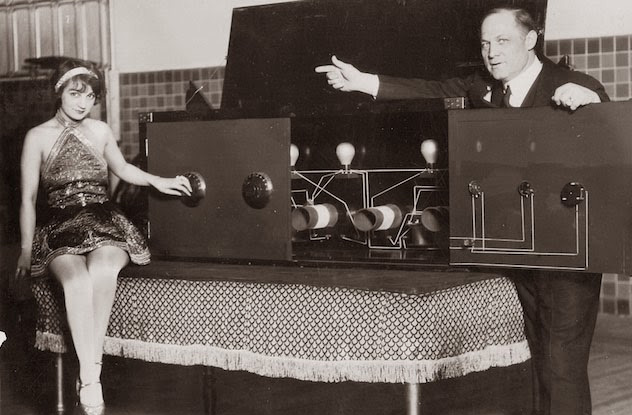
Houdini developed the “Radio of 1950” illusion for his evening shows from 1925 until his death the following year. The radio was a novelty at the time, and the act featured what Houdini said the radio would be like in 1950.
According to Dorothy Young, Houdini’s assistant, the great magician began by introducing a large table with a tablecloth that fell halfway down the table’s legs. Houdini walked around the table, lifting the tablecloth to show that there were no mirrors or anything else under the table.
Then assistants placed on the table a giant radio approximately 2 meters (6 ft) long and 1 meter (3 ft) high and wide. The front of the radio had huge dials and double doors. Houdini opened the doors to show that there was nothing inside except coils, transformers, and vacuum tubes. He closed the doors.
Houdini adjusted one of the dials until a radio station tuned in. The radio announcer said, “And now, Dorothy Young, doing the Charleston.” The top of the radio flew off, and out popped a young assistant, who jumped down and danced the Charleston.
“Tune in to any station and get the girl you want,” Houdini said. “No, gentlemen, it is not for sale.”
The Secret:
The key to the illusion was the table. Called a “bellows” table, it had two table tops. The upper top had a trap door that opened upward. The lower top hung from the upper by springs that dropped under Ms. Young’s weight without going below the skirt of the tablecloth.
Young was inside the radio when it was set on the table. She then opened the trap and slid into the bellowed area between two table tops and waited there as Houdini showed the radio’s empty interior. While the master magician dialed the radio station, she simply climbed back into the radio.
The image above is of Houdini’s younger brother, Theodore “Dash” Hardeen, demonstrating Houdini’s radio with assistant Gladys Hardeen. Hardeen purchased the radio from his brother’s estate. Dorothy Young lived to be 103 and died in 2011.
9Metamorphosis
Houdini performed the “Radio of 1950” illusion at the end of his career (and life), but he performed the “Metamorphosis” illusion at the beginning of his career, when he and his wife Bessie took their act on the road in 1894. Houdini didn’t invent the illusion, but earlier versions of the acts had featured two men changing places. Houdini exchanged places with his wife. His version became a sensation, catching the attention of the Welsh Brothers Circus. In 1895, the circus took the Houdinis on tour.
The illusion was fairly complicated. Houdini’s hands were bound behind him, and he was placed in a sack that was knotted closed. The sack was placed inside a box, locked, and strapped closed. The box was placed in a cabinet with a curtain.
Bessie stepped into the cabinet and drew the curtain closed. She then clapped three times. On the third clap, Houdini drew back the curtain, and Bessie was gone. She was found in the sack in the box, with all the locks and straps still in place and her hands bound behind her.
The Secret:
The secret of the illusion is surprisingly simple: practice. First, Houdini was an expert on ropes and knots, and his hands were tied by a knot easily slipped. By the time the sack was pulled over his head, his hands were free. The sack had eyelets around the top edge that allowed the rope to feed inside and outside the bag. Houdini simply pulled on the rope from the inside to loosen it.
After Houdini was placed in the box, he wiggled out of the sack while Bessie locked and strapped the box lid. Once Bessie drew the curtain closed, Houdini slipped out through a rear panel in the box. Contrary to the audience’s assumptions, Houdini clapped, not Bessie. He clapped once then helped Bessie climb into the box through the rear panel (without disturbing the locks or straps).
On the third clap, Houdini opened the curtain. While he unlocked and unstrapped the box, Bessie, inside, wiggled into the sack and slipped the ropes around her wrists. Harry and Bessie practiced so thoroughly that Houdini was out and Bessie in his place in just three seconds.
8The Hanging Straitjacket Escape
This act was born out of sibling rivalry. Houdini’s younger brother Hardeen had his own show, and both brothers were performing escapes from straitjackets behind screens. When one audience demanded that Hardeen escape in front of them, he obliged and received a standing ovation. When Hardeen told his older brother, Houdini decided he had to outdo his brother and developed the Hanging Straitjacket Escape. He frequently performed the act a few hours before his evening shows to draw a bigger audience.
Houdini usually performed this out on the street above a large crowd. He was strapped into a straitjacket in front of the crowd, his ankles bound. A crane lifted him up so that the audience could see what he did, enforcing the impression that there was no trick to the feat.
The Secret:
Houdini himself revealed how he escaped from straitjackets in his 1910 book Handcuff Escapes. The key was acquiring slack inside the jacket as it was strapped on.
As the jacket slid onto his arms, Houdini made sure his arms were crossed—not folded—across his chest, his stronger right arm on top. As the jacket was brought around the back, Houdini pinched and pulled outward to loosen material around his chest. As the jacket was cinched and tightened, Houdini held on to this slacked material. As the jacket was buckled in the back, Houdini took a huge breath to expand his chest. Once the jacket was in place, Houdini had a fair amount of wiggle room in front.
Once in the air, upside down, Houdini used his strong arm to violently force his weak (left) elbow to the left and away from the body. This forced the slack around the right shoulder, allowing Houdini to pull the right arm over his head. Being upside down actually helped: He used gravity to pull that arm over his head.
“Once having freed your arms to such an extent as to get them in front of your body,” Houdini wrote, “you can now undo the buckles and the straps of the cuffs with your teeth.” Once the cuffs were freed, Houdini unbuckled the neck, top, and bottom buckles. Once they were undone, Houdini slipped his arms free and wiggled out of the jacket. Despite popular belief, dislocating the shoulder was not usually necessary, and Houdini only did it as a last resort.
Houdini became so adept at this trick that he reduced his escape time from half an hour down to three minutes. For those occasions when a specialized straitjacket was strapped on, Houdini was not above palming a tool to cut the straps and buckles.
7The East Indian Needle Trick
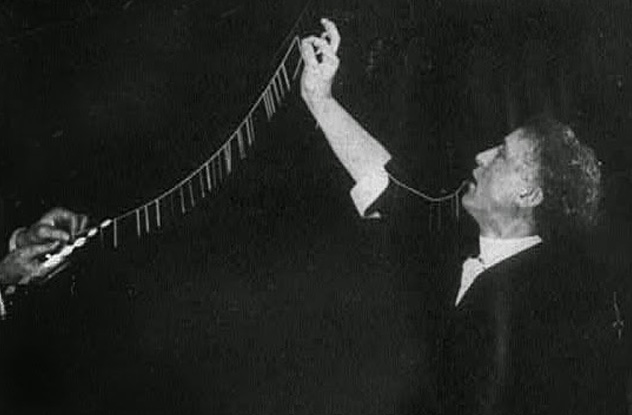
No one knows how old the illusion commonly known as the “East Indian Needle Trick” is, but it may be appropriately named. The oldest known magician to perform it was a Hindu of unknown nationality named Ramo Sami (or Samee) who toured America in 1820. It is believed that Houdini, as early as 1899, rescued it from circus sideshows for his stage show. It became a staple of his shows throughout his career.
Houdini had a spectator examine 50–100 needles and 18 meters (60 ft) of thread. The same spectator examined Houdini’s mouth. The magician then swallowed the needles and thread all at once with a drink of water. A moment later, Houdini regurgitated them, feeding out the thread, the needles dangling from it.
The Secret:
Three years after Houdini’s death, the master’s prop engineer, R.D. Adams, revealed how the trick was done. Houdini placed a packet of thread with needles already attached to it between his cheek and teeth. The needles were threaded with a knot before and after it to keep them from coming loose in Houdini’s mouth. The knots were spaced to give the needles a natural play on the thread. The thread was then rolled into a flattened packet and inserted in the magician’s mouth like a tobacco plug.
When Houdini allowed the spectator to examine his mouth, he spread his upper and lower lips away from his gums and teeth with his fingers. The fingers naturally hooked around the lips into the cheek area. Houdini hid the packet under one of the fingers. If the spectator insisted that he move his fingers, Houdini merely slipped the packet under his tongue.
Houdini then placed the loose needles and thread on his tongue and pretended to swallow them with a drink of water. In reality, Houdini spat the needles and thread into the water glass, leaving enough water in the glass so that the reflection obscured them. If the spectator remained nearby, Houdini slipped the loose needles under his tongue and kept them there until the end of the trick. Once finished, he’d take another drink of water, spit out the needles, and quickly hand the glass to an assistant. Finally, Houdini spooled out the packet of needles from his mouth.
Houdini performed a variation of this trick using razor blades. He kept the packet of pre-threaded blades in a fold of a handkerchief. On the same handkerchief, Houdini displayed loose blades to the spectator. When he supposedly placed the loose blades in his mouth, he actually placed the packet. He simply handed the kerchief to an assistant with the loose blades inside while he finished the trick.
The image above is almost certainly a staged publicity photo. The needles in the shot are far too large for Houdini to hide in his mouth.
6Walking Through A Brick Wall
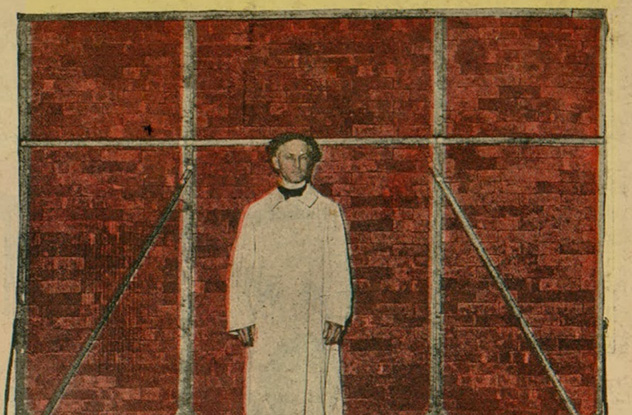
Houdini only performed this illusion a few times in a week-long run in New York City in July 1914, but it caused a sensation.
While Houdini performed other tricks, bricklayers erected a wall 3 meters (9 ft) high and 3.5 meters (10 ft) wide on the stage, perpendicular to the audience, so that the they could see both sides of it. The wall was built atop a large carpet of muslin, supposedly to prevent the use of a trap door. Once the wall was finished, Houdini invited the audience to use a hammer on the wall to show it was solid.
Once the audience was back in their seats, Houdini took position on one side of the wall, and a screen was wheeled in front of him. A second screen was wheeled to the opposite side of the wall. Seconds later, both screens were whisked away, revealing Houdini on the other side of the wall. The press reported: “The audience sat spellbound for fully two minutes after his feat was accomplished. They were too dumbfounded to applaud.”
The Secret:
The key was the rug. Instead of preventing the use of a trap door, it facilitated it. The trap was oblong and traversed both sides of the wall. Once it sprung, the carpet or sheet formed a V-shaped hammock so Houdini could crawl under the wall.
According to R.D. Adams, Houdini also performed a variation on this illusion. In it, Houdini placed a solid plate of glass under the brick wall, which indeed made it impossible to use a trap door. The screen was wheeled in front of Houdini by several assistants dressed in nondescript work clothes. After the screen obscured Houdini, he quickly changed into work clothes and joined the assistants as they walked around the back end of the wall to park the second screen on the other side. Behind the second screen, Houdini stayed and changed back into his stage clothes. Meanwhile, mechanical hands that were mounted behind the first screen waved to the audience, fooling them into thinking that Houdini was still behind it. A moment later, both screens were pulled away, revealing Houdini miraculously on the other side.
Houdini passed this trick to his brother Hardeen to use in his act. Many have speculated that Houdini stopped using the illusion because it was not his own. He’d purchased it from another magician—or even stole it, claimed a rival. The controversy (and the fact that so many knew the trick’s secret) probably made it too risky for Houdini to keep performing it.
5The Mirror Handcuff Challenge
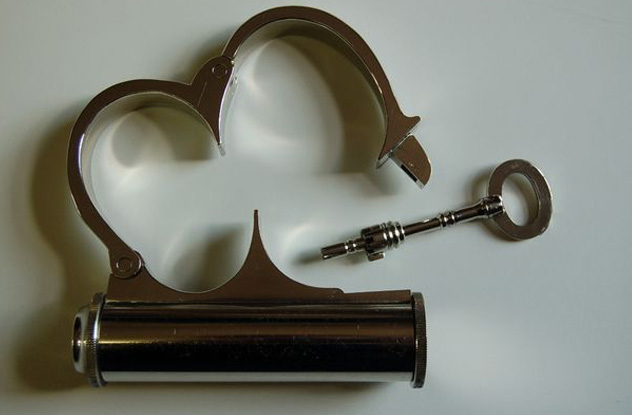
One of Houdini’s earliest acts was for him to advertise that he could escape from any handcuffs the audience or the local police could provide. His handcuff act impressed theater manager Martin Beck, and in 1899, he gave Houdini his first big break to tour vaudeville stages.
The Secret:
There was no single secret to Houdini’s handcuff escapes. The illusionist studied locks all his life and had an encyclopedic knowledge of handcuffs. He looked at the cuffs and knew what kind of key he needed. He then concealed the needed key on his person. Later in his career, Houdini invented a belt made of flexible steel that rotated on ball bearings with the flick of his elbow. The belt had several compartments with a variety of keys and picks to use.
Some cuffs didn’t require a key. He revealed in 1902 that some cuffs opened by banging them against a hard surface. When he came to a town, he’d often research the cuffs used by the local police. In his book Handcuff Secrets, he demonstrated that a loop of string could pull the screw out of a cuff’s lock.
Sometimes, Houdini had to free himself from so-called freak handcuffs, one-of-a-kind cuffs with only one key to open it. In that case, he insisted on testing the key first. While he fiddled with the cuffs, an assistant headed backstage and searched Houdini’s huge collection of keys for one that looked similar to the freak key. The assistant handed the fake key to Houdini, who then returned the fake key to the owner while he palmed the real one.
Houdini wasn’t above using specialized handcuffs. When he performed his famous bridge jumps into rivers with his hands cuffed, he often used “jumpcuffs.” These cuffs had a weak interior spring and would pass inspection. Once Houdini hit the water, a flick of the wrist opened the cuffs.
Only twice was he nearly flummoxed by handcuffs. The first time was in Blackburn, England at the hands exercise trainer and future writer William Hope Hodgson. Hodgson trussed Houdini up so enthusiastically that it took Houdini an hour and 40 minutes to free himself, complete with bloody welts.
The second time was in London, where the Daily Mirror took up Houdini’s challenge. A Mirror reporter searched and found a Birmingham blacksmith who had spent five years making cuffs that were allegedly impossible to pick. The “Mirror Cuff” featured a set of nesting Bramah locks. It took Houdini an hour and 10 minutes to free himself. Some experts speculate that the entire Mirror Cuff performance was set up by Houdini, and he had a duplicate key the whole time. They claim that he took 70 minutes to unlock the “Mirror Cuffs” for dramatic effect.
4The Milk Can Escape
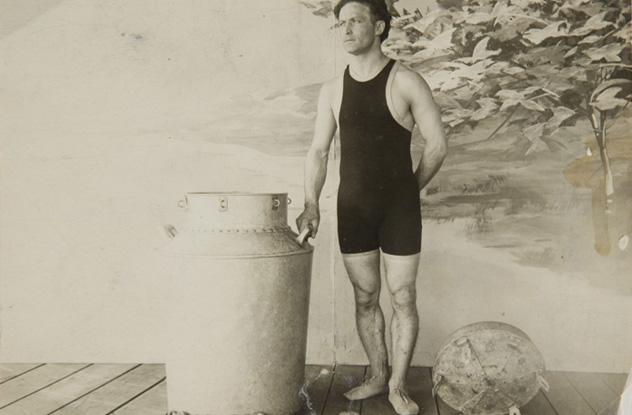
Houdini began performing one of his simplest acts in 1901. Because of his presentation, it became one of his most famous and captivating illusions. Ads for the escape ominously warned that “failure means a drowning death.” He called it “the best escape that I have ever invented.”
Houdini told spectators to examine his milk can, allowing them to kick it to verify its sturdiness. The can stood about 1 meter (3 ft) tall, and the lid had six hasps that slipped over six eyelets attached to the can’s collar. Spectators filled the can with water while Houdini changed into a bathing suit. When he returned, he asked the audience to time how long they could hold their breath. Few could exceed 60 seconds. Smiling, Houdini climbed into the milk can, excess water spilling out.
When the lid was placed atop it, Houdini was forced to submerge his head. The six hasps were secured, and locks (sometimes supplied by spectators) were clasped on the eyelets. By then, Houdini had already been underwater for at least a minute. A screen was erected around the can. Two agonizing minutes later, Houdini emerged, wet and out of breath. The locks on the milk can’s lid were still in place.
The Secret:
A few years after his death, a friend of Houdini revealed the secret: The collar was not really riveted to the can. The simple construction of the milk can made it appear secure, but the collar rivets were fake. Because the collar was tapered and greased, anyone who examined the milk can could not pull the collar off or even budge it. But anyone inside could easily push the collar up and climb out without disturbing the locks.
3The Underwater Box Escape
Houdini’s career was a steady progression of increasingly great escapes. When handcuff escapes grew stale, he moved on to jail escapes. In 1907, he jumped from bridges, handcuffed. In 1908, it was the Milk Can Escape. Finally, in 1912, it was the Underwater Box Escape. That same year, he debuted his ultimate escape: the Chinese Water Torture Cell.
His first Underwater Box Escape was made off the side of a barge into New York’s East River. Houdini was handcuffed and climbed into a wooden crate. The crate was then nailed, trussed, and chained shut. It was hoisted into the river, it sank, and 150 seconds later, he appeared on the surface a short distance away. Scientific American magazine declared it “one of the most remarkable tricks ever performed.”
The Secret:
The secret, of course, lay in the crate’s design. First, the crate had small holes in it to allow Houdini to breathe while he waited for the box to be nailed, trussed, and chained. They also allowed the crate to sink. Second, the crate was square, with four boards on each side. On one of those sides, the bottom two boards were not nailed to the crate. They only sported nail heads. Instead, the boards were a hinged trap, the opening secured by a latch. According to R.D. Adams, Houdini removed his handcuffs while the crate was nailed shut. He then waited until the crate was in the water, opened the trap, and swam to the surface.
During one box escape, Houdini waited until the crate hit the river bed before he opened the trap. The crate landed with the trap at the bottom, and the muddy bed kept the hinged door from opening. Only after desperately flailing against the side of the crate could Houdini release the trap. Ever afterward, Houdini made sure the trap was open before he reached the river bottom.
2The Vanishing Elephant
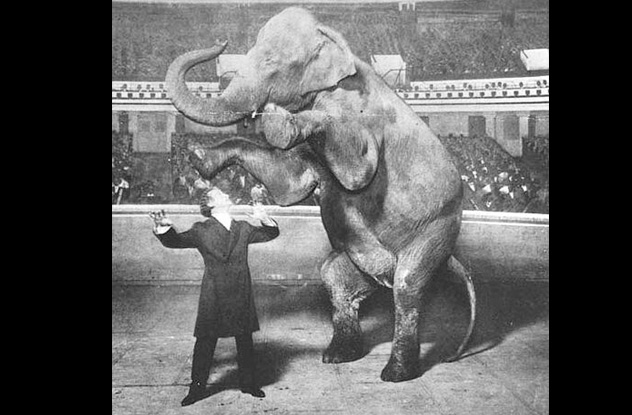
Performed only once on January 7, 1918 in New York’s Hippodrome Theater, the largest stage in the world, the Vanishing Elephant was Houdini’s most famous illusion, rivaled only by the Chinese Water Torture Cell. Houdini led an elephant into a large cabinet. And then it disappeared. As did the solution to Houdini’s trick.
The cabinet was lost, and since the illusion had been performed only once, few were privy to its secret. Even contemporary newspaper accounts of Houdini’s performance no longer exist. For years, the secret to the Vanishing Elephant was believed lost to history.
The Secret:
To piece together the illusion, we start with the Hippodrome stage. The Hippodrome no longer exists, but photos of it show a massive, 5,697-seat theater. The seats were in three semicircular tiers. No spectator had a perfect view of the elephant cabinet, which sat well back from the edge of the stage.
The cabinet’s appearance is disputed. R.D. Adams claimed that it was merely a cage-like framework. According to Adams, the lower part of the framework hid a roll of cloth identical to the rear curtains. Wires attached the cloth to a roller with a spring so strong that it had to be wound by two men. At the appropriate moment, Houdini fired a gun, causing the audience to blink. As they blinked, the roller yanked the cloth up in front of the elephant, making it seem to disappear instantaneously.
Another description of the elephant cabinet states that it was oblong, on wheels, and had double doors on one end and a huge curtain on the other. The double doors in the back had a circular opening in the middle, providing limited illumination inside the cabinet. After the elephant and its trainer entered the cabinet, the curtain was drawn, and several assistants slowly turned the cabinet around. Meanwhile, the trainer moved the elephant to the back side of the cabinet, and a black curtain was pulled over them both. When Houdini pulled open the front curtain, he had the cabinet turned again so that no one in the audience could see the interior for an extended amount of time. All they could see was the circular light from the back and a darkened interior, the elephant apparently gone.
1Chinese Water Torture Cell
Unlike Houdini’s elephant cabinet, his Chinese Water Torture Cell still exists, and we know how it worked. The great magician had the cell custom made for $10,000 and patented it.
It looked like an oblong aquarium turned on its side, it had a mahogany and nickel-plated steel frame, and its plumbing fixtures were brass. It was 67 centimeters (26.5 in) wide and 150 centimeters (59 in) tall, weighed 3,000 kilograms (7,000 lb), and held 950 liters (250 gal) of water. The front plate of glass was 1.5 centimeters (0.5 in) thick and tempered. It disassembled into three crates and four cases, and Houdini always traveled with a second cell just in case something happened to the first.
Houdini began the illusion by asking an audience member to name any part of the stage. The cell was moved wherever the spectator indicated, proving that the trick wouldn’t use a trap door. As heard on the video above, Houdini allowed the spectator to examine the cell and offered $1,000 if they could prove Houdini could obtain oxygen while inside the cell.
Houdini then lay on his back, and assistants put his feet in mahogany stocks. Pulleys lifted the magician into the air upside down, and he was lowered into the tank head-first. The stocks acted as a lid with four hasps that were padlocked to the tank. Drapes were pulled across the tank, and an assistant remained nearby with an axe, ready to break the glass if things went wrong. The orchestra played “Asleep in the Deep.” Two minutes later, Houdini emerged from behind the curtain. The stocks were still at the top of the tank, the locks still in place.
The Secret:
Two things were critical to the illusion. First, the stocks were deep-set. When Houdini was immersed into the tank, some of the cell’s water flooded over the top edge and out of the tank, allowing a small pocket of air between the water’s surface and the stocks.
Second, the mahogany boards that formed the two sides of the ankle stocks separated slightly when the hasps were locked. Once the curtain was drawn, Houdini used the sides of the tank to push his feet upward, twisted sideways, and pulled his feet through the enlarged holes in the stock. He then drew his feet to his chest, flipped, and took a breath in the air pocket.
The two stock boards were also hinged to open, and Houdini climbed out, closed the stock boards, and presented himself to the audience.
There is an urban myth that Houdini drowned in the cell. Not true. He died in a hospital bed from an infection caused by a ruptured appendix. He had only one accident while performing the act. On October 11, 1926, while the pulleys were lifting Houdini, a cable came loose and the stock shifted, fracturing Houdini’s ankle.
Steve is not a magician, just deeply curious about Harry Houdini and how he fooled the world.

